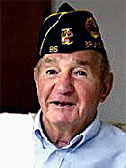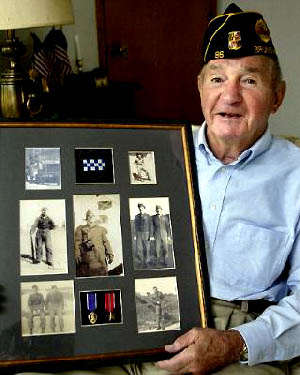
 Lawrence Herbert Dallas
Lawrence Herbert Dallas
Class
of 1948
Branch of Service: U S Army
Rank: Technician Fifth Grade
Entered Service. February 22, 1943
at Baltimore, Maryland
Discharged: January 1, 1946 at Fort George G. Meade, Maryland
Born
Died
Buried
Medals/Awarded:
Bronze Star, Purple Heart, Good Conduct, American Theatre, European
Africa Middle East Theatre, World War 2 Victory Medals and Distinguished Unit
Badge.
|
|
|
|
|
|||
|
|
|
|
|
|
|
|
| Bronze Star | Purple Heart | Good Conduct | American Theatre | European Africa Middle East | World War 2 Victory | Distinguished Unit |
Artical
from
Garzette
Rosemont
veteran
recalls
service
On
the
morning
of
Dec.
16,
1944,
bomb
blasts
destroyed
the
front
of
the
house
where
Lawrence
Dallas
had
been
asleep
for
barely
more
than
an
hour.
The
Battle
of
the
Bulge,one
of
the
bloodiest
battles
for
American
forces
in
World
War
II,
had
begun.
Dallas,
then
a
21-year-old
soldier
from
Brunswick,
had
just
completed
a
two-hour
shift
in
the
foxhole
outside
the
house
in
Hofen,
Germany.
He was tucked away in the house that served as his troop’s communication headquarters when German shells began to rain down on the wintry landscape of the Ardennes forest at 5:30 a.m.
‘‘It was a terrific shelling,” Dallas, now 84 years old, recalled from his home in Rosemont last week, where he lives with his wife of 56 years, Caroline. They have lived in the same home since 1958.
Dallas shared his war stories with a Brunswick Middle School student, via the Frederick County Veterans History, and now a description of Dallas’ service can be found in the national Veterans History Project database in the Library of Congress.
The Veterans History Project is a national effort to collect and preserve the memories of veterans from World War I to the present, through video and audio recordings.
So far, Howard Metz, director of the Frederick County Veterans History Project, said his team of volunteers has interviewed more than 125 World War II veterans in Frederick County.
A railroad brakeman by trade, Dallas’ job in the U.S. Army was to repair and lay communication and telephone wires between battalion and rifle headquarter companies. Dallas said this often put him in danger and under enemy fire.
‘‘You never knew when they were going to shell you,” he said.
Dallas’ journey to the front lines of World War II began when he was drafted in February 1943 at the age of 19.
Born and raised in Brunswick, Dallas had dropped out of high school to help support his family during The Great Depression and worked on the Brunswick railroad, as his father had. His first job was cleaning railroad cars at Union Station in Washington, D.C.
In March 1943, Dallas reported to Fort Meade for basic training and spent the next six months in Mississippi, Louisiana and Texas for additional preparation.
It was at Camp Maxey in Paris, Texas, that Dallas received a letter from home — his childhood friend who had lived down the street in Brunswick, was killed in battle. The news ‘‘worked on me a bit,” Dallas remembered.
On Sept. 29, 1944, Dallas sailed to England where he spent three weeks before crossing the English Channel to Le Havre in France, then Belgium and Germany. Dallas and the 99th Infantry Division were stationed in the area between Monschau and Hofen during the Battle of the Bulge.
One day during the conflict, Dallas said he volunteered to take another soldier’s place laying wires to a new outpost. The soldier he replaced was a married man from Baltimore with three children.
Dallas,
a
bachelor
at the
time,
said
he was
caught
in the
middle
of
German
crossfire
during
the
mission.
His
sacrifice
and
bravery
that
day
earned
him a
Bronze
Star![]() .
By the
end of
his
three-year
tour
of
duty,
Dallas
would
also
earn
the
Purple
Heart
.
By the
end of
his
three-year
tour
of
duty,
Dallas
would
also
earn
the
Purple
Heart
![]() and
the
Distinguished
Unit
Badge
and
the
Distinguished
Unit
Badge![]() for
defending
the
road
out of
Monschau.
for
defending
the
road
out of
Monschau.
For
three
sleepless
nights
Dallas
narrowly
escaped
injury
and
death
as he
and
the
soldiers
of the
99th
Division
 pushed
the
Germans
into
retreat.
‘‘We
chased
Germans
all
the
way to
Austria,”
Dallas
said.
pushed
the
Germans
into
retreat.
‘‘We
chased
Germans
all
the
way to
Austria,”
Dallas
said.
Nearly 19,000 U.S. soldiers died by the time the Battle of the Bulge was over in January 1945.
After the war ended, Dallas spent the rest of his service in Germany until he set sail on a 19-day journey from Marseilles, France, to New York. Bad weather and rough seas made everyone in his bunk seasick, he said, except him.
Dallas was honorably discharged on Jan. 1, 1946, and said he returned to Brunswick where he got his job back on the railroad after some difficulty.
He worked as a brakeman, then conductor on the Brunswick-Washington, D.C. rail lines and went back to finish high school. Although Dallas did not go to college, he said proudly that his three sons and daughter have college degrees.
Metz said Dallas tells his story with humility, which is common among World War II veterans.
Metz pointed to Dallas’ location at Elsenborn Ridge at the Battle of the Bulge’s northern front, as an example of his proximity to war. Allied troops stopped the Germans’ advance at Elsenborn Ridge, Metz said.
‘‘His story, in a way, is very humble,” Metz said. ‘‘He was in a tremendous amount of activity on the first day ... yet he played it down.”
Nominate a Neighbor
The Gazette publishes stories for the Our Neighbor series once a month. If you know someone who volunteers in their community and has an interesting story to tell, call 301-846-2100 or send an e-mail to frederick@gazette.net .
